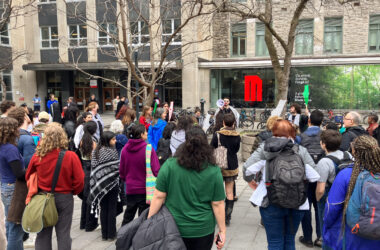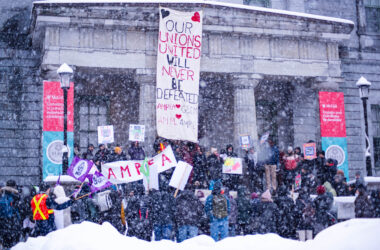In an attempt to stimulate the economy in the wake of the financial crisis and as part of an effort to improve Canada’s research infrastructure, the federal government granted McGill over $100 million in January 2008 to be used in infrastructure improvement. The money is currently fuelling an explosion of construction projects across campus. The McIntyre Medical Building, McDonald Engineering Building, and Otto Mass Chemistry Building are the three biggest projects. Each renovation will cost roughly $30 million, which must be spent before March 31, 2011 to meet the terms of the grants.
“We are trying to do all this work in these three buildings while keeping the buildings operational, so we’ve moved as many people as humanly possible out of the way to minimize the disruption on teaching and research activities,” said Associate Vice-Principal Jim Nicell (University Services). “But there is no question that it is disrupted.”
According to Nicell, McGill does not usually practice fast-paced construction, but in this case a deadline had to be met. The university generally does not invest over $500,000 per month on a project.
“Today, we are three-fold above that level,” he said. “The great thing about it is we are really trying to make sure we are doing everything in a really smart way. We are trying to make sure that whenever we fix something, we are putting it in a state that will last for the next 50 to 100 years, depending on the structure.”
Nicell explained that it was difficult to coordinate so many projects at the same time without disrupting each other and regular university activities. The federal government’s fund was added to additional funds to bring the total spent on infrastructure to $300 million.
Robert Stanley, McGill’s director of project management, explained that having to spend the money within two years constrained McGill enormously, especially since buildings still need to be occupied and the functionality of the university has to be maintained.
“It would be different if we could empty a building and then just move in, but we can’t. [Professors] still have their teaching that has to go on,” Nicell said. “And of course, with the Quebec and federal governments wanting to show progress on stimulus of the economy, we were stuck with these very firm deadlines.”
Out of the nine projects proposed to the federal government, four were approved. McGill’s strategy centred on individual buildings.
“The practicalities of the timeline forced us to look at certain projects as a priority, so we did [it on] a building-by-building basis,” Nicell said.
Although it is a federal initiative, the provincial government has contributed 50 per cent of the funds for the construction projects. Besides the three major construction projects, there are also a number of deferred maintenance projects going on at McGill. According to Stanley, these are “the renewal of systems and installations that are worn out, that were not dealt with in the past but need to be dealt with to consolidate the university’s infrastructure for the future.” These deferred maintenance projects include the restoration of the Arts Building facade, the roofing of the Redpath Museum, the reconstruction of the exterior terrace at the Stewart Biology Building, and some less visible projects, such as the Lyman Duff Building upgrade. All of these were funded by Quebec as part of the Capital Grant for the university from the Ministry of Education.
“We made a case three years ago and basically the government acknowledged that we had a major deferred maintenance project, and a lot of it is because of the nature of our buildings-they’re historic,” Nicell said. “They have already given us two installments of $25 million a year for deferred maintenance.”
Other projects include the Service Point, which is in its final stage, the $36 million brain imaging centre at the Montreal Neurological Institute, the pipe replacement along Dr. Penfield Avenue-which was funded by the city of Montreal-and the Molson Stadium expansion, which was funded by Quebec, the City of Montreal, and the Alouettes.
“Behind the scenes there are well over 800 projects at the university, ranging from a tiny $1,000 here and there up to multimillion-dollar projects,” Nicell said. “It’s a huge number that we are managing right now.” The current construction boom is the largest in decades, Stanley said.
“The university has never had such an intense itinerary of construction projects ongoing at the same time,” he said.
Diane Liegey, a U3 political science student, said she was happy with the finished projects at McGill.
“The last construction by the ex-Milton Gates is great, it looks much nicer now, there’s more space to sit down and eat so I am happy McGill is making all these changes,” said Leigey. “As long as it doesn’t affect my studies I really don’t mind. If they were cutting back on space for students to study or removing classroom space then I would be upset about it, but they have managed to keep disruptions to a minimum.”








